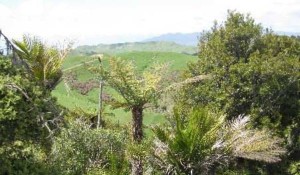
(Last paragraph corrected 15.07.14 with information provided by Dave Collins)
While WWI was about to start in Europe, supporters of a railway for Raglan met to plan the line. Raglan locals Dr. Moore and Messrs, Rawlinson and Langley were enthusiastic supporters of the scheme. A public meeting in the Raglan Town Hall in 1912 had first proposed the railway and in July 1914 a meeting was called in Hamilton to move forward with the project. During the war years not much was done. Then in 1920 a Board was set up to investigate the railway.
Possible routes were surveyed by Rupert Worley and the route finally selected was from Frankton Junction to Karamu, up the Aramiro valley and out through a 10 chain tunnel into the Waitetuna valley. From this point the line ran down the Waitetuna valley, and thence followed the main road route to Te Uku School. Then the line ran down through what was then a swampy area to Wallis’ farm, crossing this and coming on to the Raglan harbour, near the dairy factory — a very direct route to Raglan. Everything was all set to raise the loan for the proposed work when the Government of the day stepped in. Gordon Coates, as Minister of Public Works made a firm promise to the people of the district, that if they would drop the light railway scheme, the Government would provide a sealed highway to Raglan within 5 years. It must be remembered that at that time the roads were deplorable. The people fell for this promise and ditched the planned railway.
The New Zealand Herald of 17 July 1914 reported that, “A meeting in Hamilton of the committee set up last week to consider the question of the connecting of the West Coast ports of Kawhia and Raglan with the Main Trunk line was presided over by Mr. F. Ernest Smith, promoter of the scheme. There was a good attendance, representative of Raglan, Kawhia, Frankton, and Hamilton.
Mr. Smith again outlined the scheme, for which, he said, £250,000 was available as soon as- the law had been complied with. Since the first meeting, he had many letters and telegrams approving the new venture, which would develop a large district, a great portion of which consisted of good land. He estimated that a rate of one penny, would produce more than sufficient to provide interest on the cost of construction, while all profits from the working of the line would go to reduce these rates. At the same time the value of the land served would be at least doubled.“All of the delegates supported the proposal, and a Central Committee, consisting of Messrs. F. E. Smith, Darke, F. B. Jolly, J. S. Bond, and Clark, was set up to place the project before the settlers at the various centres. Local committees were appointed as follows: Kawhia, Messrs. Chase and Scott; Raglan, Dr. Moore and Messrs, Rawlinson and Langley; Waitetuna, Messrs. Jeffries, Ranson, and Cooper; Karamu, Messrs. Bruce, Steele, E. J. Smith, and Morony; Tuhikaramea, Messrs. Binney and S. Reid; Teuku [Te Uku], Messrs. Ralfe, Wallace, and Husband. Engineering and other reports will be at’ once prepared, and the Central Committee will commence its visit of the various districts in October.”

